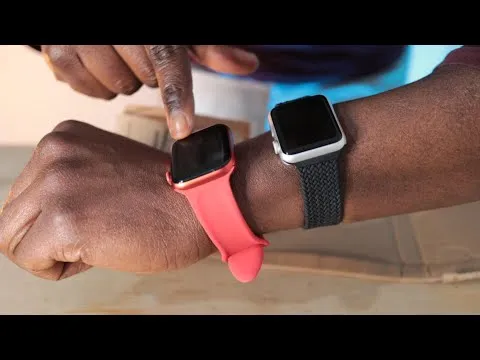Product (RED) Apple Watch
I used to wear watches back in the day, starting with the tiny analog ones my parents got me when I was a kid, all the wayto the gold-plated Seiko watch that's still sitting in the back of one of my storage boxes till this very day. I stopped wearing watches when smartphones arrived and pretty much replaced most of my gadgets. Once upon a time, individual, dedicated gadgets were a thing; calculators, watches, cameras, sat-nav, torchlights (flashlights), portable tape/CD player e.t.c, all bulking up your man-bag. Nowadays it's just the one device, or two at most.
Smartwatches brought back the wrist watch in a big way. As usual, Apple wasn't the first but played a massive role in normalising the smartwatch - much like they did with the smartphone, tablet and digital audio player before them. Sadly, like most things these days, these devices are not expected to last. They are designed with planned obsolescence built in. It means no matter how hard you try, and how careful, something breaks and renders the device less than optimum in order to encourage you to buy the latest version.
The thing is, said latest version is often not that much better, if at all, than the previous one. This is increasingly true these days when a new product is expected every year. How much more can they squeeze into a watch, for instance, that will warrant a new one in just a few months? That is why they have to break your device to give you that push to buy. If all fails, they will divorce your device from vital services or literally reach into your device and dead-switch something. Apple was caught doing this to iPhones in the past.
Buying refurbished
I almost never buy the latest version of anything. Firstly, I like to wait for the problems to be discovered and ironed out. Even then, I usually wait till the novelty wears out, and the new version premium is removed, so I pay significantly less for it. Even then, I usually use my devices to death. I don't feel the need to have the latest and greatest stuff. I still use the original Apple Watch released many years ago - a century in dog years!
I also enjoy buying up-cycled, recycled or refurbished stuff. That is why I'm a fan of refurbished gadgets. These could be previously owned devices that have been brought to date; perhaps the battery changed for a new one, for example, such that it performs like a new device. Like I mentioned before, planned obsolescence is usually implemented by including just one weak link in the chain that breaks. The battery, glass screen that gets scratched or a chip that burns out over time, are such examples. The refurbishing process replaces these components often for better, longer lasting ones.
I also like buying from organisations that benefit the world somehow. The sourcing of components for our devices causes enough damage to the planet and her people already. I try to at least remove some of that harm by giving my money to companies that care or programs that go to address some issue that benefits someone somewhere in a non exploitative way.
Product (RED)
The very first iPod I ever bought was a Product (RED) one, and I still have it today. I also bought it with a Product (RED) American Express card, which I still also use. In fact I am sipping on a cup of coffee purchased with said card.
Product (RED) is a brand that collaborates with big companies like Apple, Nike, and Starbucks to create special edition products. These products are designed to raise awareness and money for the Global Fund to fight HIV/AIDS. Tuberculosis and malaria research were also added as beneficiaries. Every time I spend on my card, 1% of it goes to that endeavour. When I purchase anything Product (RED), a percentage of it goes to the cause.
It was a big deal in the 1980's, but now that it's pretty much under control here in the west, what was once an existential risk for humanity has been pushed to the back of our minds. Apparently over 38 million people are currently living with HIV, and nearly 700,000 people die from AIDS-related illnesses annually! This is a crazy number!
The nature of the disease means that it doesn't actually kill you - something else does. It removes your defences to fight diseases, so something as common as a cold would prove fatal for someone with AIDS. In Africa, the continent with some of the highest numbers of HIV related deaths, malaria is the main cause. Tuberculosis is another one. The heartbreaking part is that many are children. The story isn't too different in other parts of the world like South America and parts of Asia. Childhood diseases that would be fought off easily by uninfected children would prove fatal for children with HIV.
By the way, we have treatments for the very effective management of HIV now, which is why it's pretty much forgotten about here in the west, but Big Pharma says they haven't made enough money yet, so refuse to allow developing nations to produce their own meds based on the formula. That's a different story for a different day I guess. Brazil, a country with some of the highest numbers of HIV sufferers, put the middle finger up to Big Pharma.
What I like the most about Product (RED) is that one needs not do anything extra. That's the best type of fund raising in my opinion. I wish more things were like that; rent, mortgage, food, even income tax. Using a credit card that donates to the fund at least diverts a few pennies that direction I suppose.
Peace & Love,
Adé
